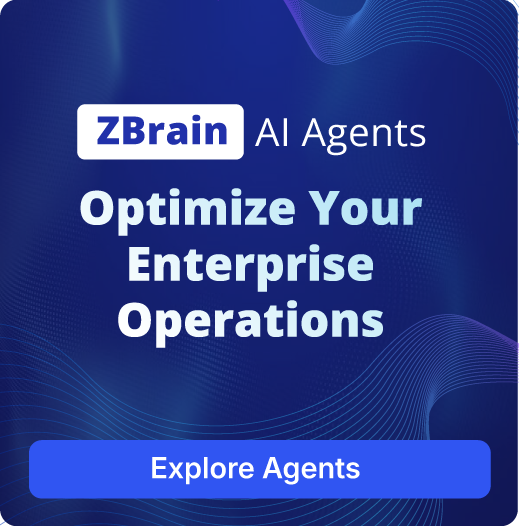ZBrain agent crew: Architecting modular, enterprise-scale AI orchestration
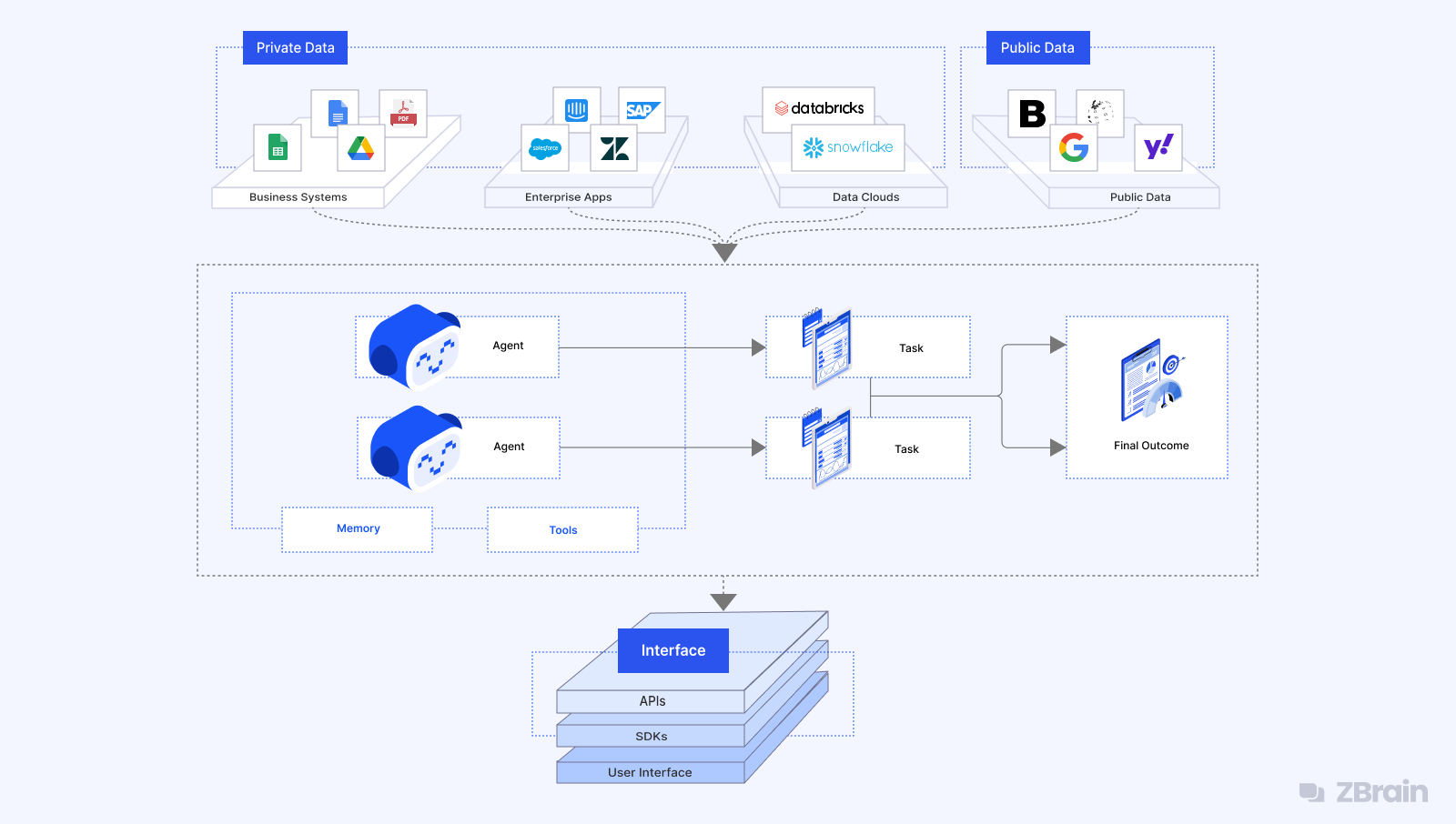
Listen to the article
Organizations are rapidly moving from isolated, standalone agents to coordinated crews of specialized agents, and market projections reflect the scale of this shift: Markets & Markets projects the AI agent market will rise from $7.84 billion in 2025 to $52.62 billion by 2030 – a 46% compound annual growth rate (CAGR). Capgemini’s 2024 survey of more than 1,000 executives shows that 82% of organizations plan to deploy agents within three years. Gartner goes further, predicting that autonomous agents will handle 15% of routine business decisions by 2028, up from 0% in 2024. In that scenario, multi-agent orchestration—where a supervisor agent coordinates a crew of specialized, role-based agents—has emerged as the most credible architecture for converting LLM breakthroughs into enterprise-grade value.
Breaking big problems into focused roles is not just elegant design; it delivers measurable gains. Anthropic’s research show that delegating subtasks to parallel, role-specific agents can unlock significant speed and quality improvements (approximately a 90% reduction in time for broad, research-style queries). The trade-off is cost: Duplicating context across agents multiplies token usage, so this architecture is most valuable when the extra insight or faster turnaround outweighs the higher compute spend.
Crucially, the AI toolchain has matured to make all this practical. LangGraph offers StateGraph, which is used to edit and generate the structural representations of public multi-agent scripts, allowing developers to implement robust contexts suitable for various interactions. Google’s Agent Development Kit provides event-driven APIs to orchestrate BaseAgent instances together. Additionally, ZBrain Builder offers a low-code, visual interface that enables the creation of multi-agent workflows. With market demand, proven advantages and accessible tooling converging, agent crews are poised to become the default pattern for scaling AI across modern enterprises.
This article provides a comprehensive overview of multi-agent systems, covering fundamental principles, enabling frameworks (such as LangGraph, Google’s ADK and Microsoft Semantic Kernel), enterprise benefits (scalability, adaptability, efficiency) and a detailed look at ZBrain’s implementation of agent crew for enterprise AI orchestration.
Principles of multi-agent orchestration

Task delegation: Complex tasks can be broken down into subtasks and assigned to specialized agents best suited for each subtask. A manager or supervisor agent can assign responsibilities to worker agents, which are essentially child agents that execute a unit of work and ensure all components of the workflow are completed. This hierarchical delegation mirrors the coordination of a real-world project manager with a team. It prevents any single agent from becoming a bottleneck or being overloaded, scenarios that often cause confusion and errors.
Coordination and communication: Agent crews maintain inter-agent communication to enable agents to share intermediate results, request assistance or synchronize their actions. They often operate over a shared memory or state, giving each agent a consistent view of the task’s context. For example, one agent can pass data it has collected to another agent responsible for analysis. A central orchestrator engine keeps the team tightly coordinated, ensuring that dependencies and execution order are handled correctly.
Autonomy of agents: Each agent in the crew has a degree of autonomy to make decisions within its scope. Agents are typically powered by large language models (LLMs) configured with a specific persona or goal, enabling them to plan actions and use tools independently. The system as a whole can exhibit emergent problem-solving behaviors, as agents reason and act in concert without needing step-by-step human instructions. Modern multi-agent frameworks often incorporate a top-level manager agent to oversee the others, achieving an autonomous hierarchical workflow. This autonomy means agents can respond to dynamic inputs or unexpected conditions by adjusting their plans, collaborating via back-and-forth dialogue or notifications, and even invoking additional helper agents if needed.
These principles enable multi-agent systems to handle complex, multi-step tasks that are beyond the scope of a single agent. Multi-agent systems tend to thrive especially when multiple distinct execution paths or specialized skills are required in parallel, outperforming a linear chain-of-thought approach in such cases. In practical terms, a well-orchestrated agent crew can solve problems faster (by solving steps concurrently) and more reliably (by using the right expertise for each step) than an equivalently tasked single agent.
Streamline your operational workflows with ZBrain AI agents designed to address enterprise challenges.
Frameworks for agent crew orchestration
Implementing a robust agent crew requires a supporting framework that handles the mechanics of agent communication, task scheduling, state management and tool use. In recent years, several frameworks have been developed to simplify the orchestration of multi-agent systems.
Prominent examples are LangGraph (from the LangChain ecosystem), Google’s Agent Development Kit (ADK) and Microsoft Semantic Kernel. These frameworks exemplify how multi-agent collaboration and decision-making can be enabled in practice, each with a distinct approach:
LangGraph (LangChain): LangGraph is an orchestration framework introduced by the LangChain team to manage complex agent workflows using a graph-structured approach. Instead of a simple linear chain, LangGraph allows developers to define a directed graph of interactions: nodes can be LLM-powered agents or tools, and edges represent the flow of information or triggers between them. This graph-based, stateful workflow provides fine-grained control over multi-agent communication and actions. LangGraph offers broad compatibility with various LLMs and tools (leveraging LangChain’s extensive ecosystem of integrations), and it comes with utilities for debugging and visualization (e.g., LangSmith) to help design and monitor the agent graph.
Because the developer explicitly defines the structure of the agent interactions (the “map” of the crew’s process), LangGraph workflows can enforce clear logic and ensure each agent’s state and memory are handled in a controlled way. In summary, LangGraph is well-suited for structured, deterministic multi-agent flows where interactions can be planned as a graph, such as workflows that route tasks through a sequence of specialized agents and may loop back based on specific conditions. It gives the developer full control over these flows, which is excellent for complex enterprise processes that require transparency and precise governance.
Google ADK (Agent Development Kit): Google’s ADK is an open-source framework designed to simplify the creation of intelligent agents and multi-agent systems, with strong integration into Google Cloud’s Vertex AI platform. ADK provides a high-level API that abstracts much of the complexity in agent orchestration, including built-in state management, messaging and debugging support. A standout feature of ADK is the ability for one agent to invoke another agent as a subroutine – essentially treating a subordinate agent like a function call. This makes it straightforward to implement hierarchical task delegation: a “parent” agent can break a complex problem into pieces and call different “child” agents to handle each step, then aggregate the results. ADK manages these calls and returns responses automatically, so developers don’t have to write custom orchestration logic for each delegation.
The framework also supports memory scoping, meaning each agent can maintain the context of its conversation or task, isolated from others to avoid context mixing or data leakage. Furthermore, ADK supports tool attachments – developers can equip agents with external tools or functions (e.g., database queries, web search, calculators) that the agent can invoke as needed. This extends an agent’s capabilities beyond the base LLM, enabling it to take actions in the real world or retrieve precise information. In effect, ADK offers a powerful combination of structured orchestration (through sub-agent calls and state control, such as current status, context and the progression of an agent or sub-agent’s task execution) and action-oriented flexibility (through tool use). It is particularly geared toward enterprise-grade applications, given its tight integration with Google Cloud’s infrastructure and services for scaling and monitoring. Many patterns for multi-agent workflows – such as sequential pipelines, parallel fan-out processing, conditional task routing and iterative loops – can be implemented readily with ADK’s primitives and its support for an agent-to-agent (A2A) communication protocol in distributed settings.
When to use which? Each framework has its strengths. A recent comparative analysis noted that ADK excels in large-scale, production use cases that benefit from Google Cloud integration and robust tooling, whereas LangGraph provides granular control over complex agent interactions for those who want to explicitly design the flow logic.
In practice, framework choice depends on the project’s needs: ADK might be ideal for an enterprise that wants quick development and managed deployment on Google Cloud with built-in reliability features, while LangGraph might appeal to a team that requires custom workflow design, diverse model and tool support, and is comfortable managing the orchestration logic themselves. It is worth mentioning that other frameworks also exist, such as AutoGen, IBM’s crewAI and Amazon’s agent toolkit, but they all address similar challenges in orchestrating multi-agent systems, each with a different emphasis. Regardless of the framework, the goal is to make it easier for agents to collaborate by providing the necessary infrastructure (messaging, memory, tool APIs, etc.) so developers can focus on the high-level behavior of the agent crew rather than low-level plumbing.
Strategic importance of agent crew systems for enterprises

Scalability and performance: Multi-agent systems can handle growing workloads and complexity more gracefully. By dividing tasks among multiple agents, work can often be done in parallel, drastically reducing execution time for high-volume workloads. If an enterprise needs to process thousands of documents or customer queries, a crew of agents can split the dataset and work concurrently, then combine their outputs much faster than one agent handling them sequentially. Moreover, adding capacity can be as simple as introducing additional agents for new functions or to share the load. Instead of overloading one “super-agent” with more and more capabilities, a multi-agent approach scales out by plugging in new specialized agents as needs evolve.
This modular scalability is analogous to adding more teams in a department when workload increases, rather than trying to train one person to do everything. It also enhances performance under uncertainty: Research suggests that multi-agent setups exhibit enhanced reliability and can better tolerate noisy or incomplete data, as agents can cross-verify and focus on distinct aspects of a use case. In enterprise settings where volume and variability of data are high, this scalability and resilience are critical.
Adaptability and modular flexibility: Agent crews are inherently adaptable. Each agent in the crew can be updated or replaced without requiring the entire system to be dismantled and rebuilt. This is especially important in enterprise environments where requirements change, new data sources emerge or regulations necessitate adjustments to the process. With a multi-agent design, if you need a new capability (say, an agent that handles a new type of analysis or integrates with a new software system), you can develop or plug in that agent alongside the existing ones. The other agents continue in their roles, often requiring minimal changes to accommodate the new agent, as long as the interfaces are well-defined.
Because agents communicate over well-specified channels – internal tool APIs (OpenAPI-registered JSON calls), orchestrator-managed data handoffs (typed payloads/JSON), MCP connectors to external systems (HTTPS REST/GraphQL), webhooks for inbound/outbound events and shared knowledge-base retrieval (RAG queries with structured results) – the interface specifications ensure that the rest of the system remains stable as parts are changed. This modularity is akin to swapping or upgrading a microservice in a software architecture without affecting the whole application.
In contrast, a monolithic AI agent would require significant retraining or reprogramming to extend or modify its functionality. Multi-agent frameworks encourage designing agents with narrow, well-defined roles, which makes it easier to optimize or replace one component at a time. The composition of the agent team can also be reconfigured dynamically – for example, disabling an agent that is not needed for a certain input or invoking an extra helper agent for a particularly challenging case. All of this gives enterprises a flexible toolkit to adapt AI workflows as business needs evolve, without starting from scratch.
Task efficiency and expertise: In an agent crew, each agent’s specialization leads to deeper expertise and better output quality for its given task. A focused agent (for example, one dedicated to parsing legal contracts) can use a prompt and tools finely tuned for that domain, yielding more accurate results than a generalist agent juggling multiple domains. When these focused outputs are combined, the overall task is done with higher quality.
Parallelism also improves efficiency – multiple parts of a task can be completed simultaneously. For instance, a crew handling a compliance report might have one agent gathering data while another analyzes policies and another drafts the report, all at once. This not only saves time but also allows for real-time collaboration where agents feed intermediate findings to each other.
Multi-agent systems, therefore, excel at complex workflows where different types of processing are needed in tandem. Additionally, agent crews can incorporate decision points (one agent might act as a reviewer or validator for another’s work), catching errors or refining outputs internally. This built-in redundancy and review mechanism ensures that the final output is more robust and trustworthy, a key efficiency when considering the cost of errors in enterprise processes.
Enterprise alignment (governance and observability): Agent crew systems can be designed with enterprise governance in mind. Having multiple agents with delineated functions can make it easier to enforce policies and monitor behavior. Each agent can have guardrails in its instructions specific to its function (e.g., a finance-reporting agent can be constrained to use only approved data sources; a customer-facing agent can be filtered for tone and compliance). Orchestration frameworks often provide centralized logging and tracing for multi-agent workflows.
This means that as agents work together on a task, all their actions, intermediate decisions, tool calls and outputs can be recorded and reviewed in one place. For a CIO or CTO, such observability is invaluable: It provides transparency into how an AI-driven process is executing, which is critical for debugging, auditing and trust.
Multi-agent systems typically include monitoring dashboards to track performance metrics of each agent (e.g., response times, success rates) and of the overall crew process. This aligns well with enterprise needs for SLA monitoring and continuous improvement. If one agent in the crew becomes a bottleneck or fails frequently, it is isolated and can be adjusted without impacting others. In sum, an agent crew not only amplifies capability but also lends itself to enterprise-grade manageability, enabling AI orchestration to meet organizational standards for security, compliance and reliability.
Use case illustration: To ground these benefits, consider a practical scenario like enterprise customer support. In a traditional setup, a single AI chatbot might handle a user question end to end, which limits it to what it can answer from its training and a fixed knowledge base. In a multi-agent approach, you could have a customer support crew composed of specialized agents: One agent focuses on understanding the customer’s query and sentiment, another agent (with tool access) fetches relevant account information or knowledge base articles, and another agent handles taking actions (like opening a support ticket) via API calls. These agents work under a coordinator agent that ensures the conversation flows logically.
The agents collaborate by sharing data (e.g., the information retrieved) and each sticks to its expertise. This crew can resolve issues more effectively: The information-retrieval agent ensures accurate facts are provided, the action agent ensures the solution is executed and the conversational agent keeps the customer engaged. Such a system is measurably efficient – success is determined by resolution of the issue – and companies have started adopting this pattern. The same pattern can apply to many domains (from financial analytics to IT operations), demonstrating why agent crew systems are a strategic investment for enterprises aiming to scale AI-driven services.
ZBrain’s agent crew architecture and implementation
ZBrain, an enterprise agentic AI orchestration platform, has embraced the agent crew concept as a cornerstone of its solution for building and deploying AI agents. ZBrain’s implementation of agent crews provides a structured yet flexible framework for enterprises to configure multiple AI agents that collaborate on complex tasks.
The platform provides a user-friendly interface for designing these multi-agent crews, along with robust back-end integrations to support their operation at scale. In this section, we explore ZBrain’s agent crew architecture and its key steps, including the addition of components in multi-agent orchestration. The key steps to building an agent crew are as follows:
Crew overview, crew structure definition and tool integration.
Crew overview – defining an agent crew in ZBrain Builder

You start by giving the crew a name and description to clarify its purpose (for example, “Content Manager Crew – coordinates writing and reviewing of content”).
You then select the underlying orchestration framework for this crew, choosing between supported options such as LangGraph, Google ADK or Microsoft Semantic Kernel, depending on the desired style of interaction. ZBrain Builder deliberately offers a choice of frameworks to suit different use cases: LangGraph for graph-based, memory-aware workflows and ADK for reactive, event-driven agent processes. This means a ZBrain agent crew can leverage LangChain’s orchestration capabilities or Google’s agent toolkit under the hood, all through a unified interface.
Next, you choose the primary LLM model that the agents in this crew will use as their reasoning engine. ZBrain Builder is model-agnostic and compatible with a wide range of leading LLMs – GPT from OpenAI, Anthropic Claude, Google’s Gemini family, Meta Llama variants and even custom models. This flexibility allows enterprises to tailor the intelligence of the crew to their specific needs.
You can also set how the agents should store the memory so that you can trace by selecting the memory options.
Finally, you set the crew’s access permissions (public vs. private), controlling who in the organization can operate or trigger this multi-agent workflow. The crew overview essentially establishes the playing field and rules for the agent team, outlining what they are collectively tasked to do, which LLM they primarily rely on and under which orchestration paradigm they will operate.
Crew queue – defining the input source
Define the input source for the agent crew. It could be a webhook or another third-party data source.
With the high-level crew settings in place, the next step is crew structure definition.
Crew structure definition – designing the team of agents and their relationships
The user can add multiple agents to the crew, either by selecting from a library of prebuilt agent flows or by defining new custom agents. For each agent, you specify its role, responsibilities and logic. This often involves writing a prompt or instructions that encapsulate the agent’s persona and task (e.g., “You are a proofreading agent. Your job is to receive a draft text and return a list of grammatical corrections and suggestions.”). You also assign any domain knowledge or data sources the agent should use. ZBrain Builder encourages a design where each agent has a focused purpose, aligning with the principle of specialization – for example, one agent might do data extraction, another performs analysis and another compiles an answer. It also supports tool integration and access to the MCP server.
Once the agents are defined, you orchestrate the flow of the task among them by drawing connections between agents and defining triggers or handoffs. For example, you might configure that when the supervisor agent receives a new task request, it first invokes Agent A (data collector), then passes Agent A’s output to Agent B (analyst) and Agent C (writer) in parallel, and finally sends both outputs to Agent D (reviewer) before producing a final result. ZBrain’s orchestration engine supports such complex patterns (sequential, parallel and conditional branching) in a visual manner.
Under the hood, if LangGraph is the chosen framework, these connections form the graph that LangGraph executes; if ADK is chosen, ZBrain Builder translates the design into ADK’s workflow of subagent calls and message passing. The supervisor agent (or “manager”) can be one of the agents explicitly defined by the user or an implicit orchestrator generated by the framework. Either way, this top-level agent manages the sequence according to the defined structure. By the end of this setup, the enterprise user has effectively designed a coordinated multi-agent system, each with a job description and a clear structure on how they collaborate to handle an input and produce the desired output. ZBrain Builder handles deploying this multi-agent workflow so it can be invoked on demand or integrated into business applications.
Tool integration – MCP server and agent tools
A powerful aspect of ZBrain’s agent crew architecture is its integration of tools and external services, enabling tool-augmented agents. In many real-world workflows, simple text generation using LLMs is insufficient. Agents need to query databases, call APIs, perform calculations or execute actions in other software systems. ZBrain Builder addresses this by letting users attach custom tools or connectors to each agent in the crew. Through an integrated code editor, developers can write custom tool functions or select from a catalog of prebuilt connectors (for services such as Salesforce, databases and email) and make those available to the crew.
For example, an agent in the crew could be given access to a “CRM database lookup” tool or an “Excel report generator” tool, which it can invoke when its prompt logic deems necessary. These tools act like additional skills the agent can deploy, turning an autonomous agent into a tool-augmented agent with the ability to take actions beyond the language model’s native scope. ZBrain Builder provides a “My Tools” library to manage these attachments and reuse them across agents and projects. It also offers an external package inclusion option.
From the perspective of the agent crew, some agents might be largely autonomous (relying mostly on the LLM’s reasoning on the given context), while others are heavily tool-augmented (for example, an agent that mostly orchestrates a sequence of API calls based on an LLM plan). The platform does not rigidly distinguish these as different types – rather, it is a spectrum where you configure how much an agent relies on outside functions.
Another notable integration in ZBrain’s agent crew is support for MCP (Model Context Protocol) servers. MCP is an emerging open standard that allows external services to provide context or specialized functions to LLMs in a consistent way. In practice, an MCP server might be a customized service that holds proprietary data or performs computations (for example, a financial calculation or a real-time data feed) that the LLM agent can consult.
ZBrain Builder enables users to add and configure MCP servers as part of an agent crew’s environment. Via the interface, one can register an MCP server’s endpoint and expose its functionalities to the agents. These MCP servers then appear to the agents as tool-like resources they can call upon during execution. For instance, if an enterprise has a proprietary knowledge base service accessible through MCP, an agent can query that service to fetch up-to-date business data while working on a task.
By integrating MCP, ZBrain’s agent crew can tap into a broad ecosystem of third-party and custom tools without hard-coding them. MCP standardizes how LLM agents discover, communicate with and invoke external services. This is especially strategic for enterprises: It means an agent crew can be extended with new capabilities simply by deploying or connecting to new MCP-compliant tools (ranging from databases to compliance checkers). ZBrain Builder handles the connection details, supporting multiple data transport methods (local, HTTP streaming, etc.) similar to other crew frameworks.
Deployment and monitoring
Once an agent crew is configured (overview completed, agents and tools set up, MCP servers connected), it can be deployed and executed within the ZBrain Builder platform. Each crew comes with an operations dashboard for runtime management and monitoring.
From the crew dashboard, users can upload input data, receive streaming inputs, trigger the crew to run and observe as the agents carry out their tasks step by step. The interface provides visibility into the execution sequence, including which agents are active, what each agent receives as input and produces as output, and how the data flows through the crew’s defined structure.
This traceability is crucial for establishing trust in autonomous systems. If something goes wrong or an unexpected output occurs, the team can inspect the logs to pinpoint which agent or step was responsible. ZBrain Builder also logs performance metrics for each run, including session timing information, cost (for example, token usage per LLM call) and other relevant details, consolidating these into reports.
Over time, an enterprise can review these metrics to identify opportunities for optimization (for example, if one agent slows things down or consumes too many tokens) and continuously improve the crew’s effectiveness. Moreover, ZBrain Builder supports human-in-the-loop intervention when necessary – an operator can be notified if the crew reaches a point of uncertainty or a decision threshold, allowing a person to guide the next step.
This ensures that while agent crews can run autonomously, they remain under oversight and control – a compliance requirement often found in enterprises. The ability to monitor and manage multi-agent workflows in real time, and to adjust components easily, means ZBrain’s agent crews can be confidently integrated into production business processes, knowing they are auditable and tunable.
Streamline your operational workflows with ZBrain AI agents designed to address enterprise challenges.
Benefits of the ZBrain agent crew feature for the enterprise
ZBrain’s agent crew turns collections of specialized AI agents into cohesive, governed workflows with minimal configuration. Below are the key ways ZBrain’s agent crew transforms AI adoption at an enterprise scale; together, they demonstrate why orchestrating specialized agents on a low-code platform creates value far beyond isolated models.
Low-code, structured multi-agent orchestration
ZBrain Builder lets teams compose specialized AI agents into end-to-end crews without writing custom integration code, drastically shortening time to value.
Automation of context-rich, decision-heavy workflows
Agents can read, reason and act across disparate systems – so complex tasks that once needed multiple human handoffs become fully automated.
Enterprise-class guardrails out of the box
Built-in security, role-based access and prebuilt integration libraries keep AI initiatives compliant, auditable and easy to maintain.
Cloud- and model-agnostic by design
Swap underlying LLMs or move from cloud to on-premises without redesigning workflows, ensuring long-term flexibility and cost control.
Blueprint for scalable AI adoption
Agent crew provides the orchestration layer that integrates specialized AI capabilities into cohesive, governed solutions, enabling enterprise-wide impact as AI adoption scales.
Conclusion
Agent crew systems represent a significant step forward in AI orchestration. By enabling multiple AI agents to collaborate – each with focused expertise and the ability to communicate and use tools –agent crew systems address many limitations of single-agent approaches. For technology leaders, the promise of multi-agent orchestration is the ability to automate complex, multistep business processes with intelligence and agility, ultimately achieving outcomes that an individual AI agent could not manage alone as efficiently. Frameworks such as LangGraph, Google’s ADK or Microsoft Semantic Kernel have paved the way by providing the necessary scaffolding to build and manage such agent teams, striking a balance between structure and autonomy. Enterprises that leverage agent crew architectures gain in scalability (through parallelism and specialization), adaptability (through modular agent design and the easy integration of new capabilities) and efficiency (through faster and more accurate task completion, as well as optimal use of AI resources).
ZBrain Builder’s implementation of agent crew showcases how these concepts can be brought into a cohesive platform, offering an intuitive way to define agent hierarchies, equip them with tools and knowledge, and deploy them in production workflows with full oversight. The inclusion of advanced integrations, such as MCP servers, and the flexibility to choose different orchestration frameworks underscore a crucial point: Interoperability and openness will be key in the multi-agent future. Organizations will want their AI agents to plug into all manner of internal and external services and to coordinate with other agents. A well-architected agent crew system positions an enterprise to orchestrate not just a few agents in isolation but an entire ecosystem of AI tools working in concert.
In conclusion, agent crew systems in AI orchestration bring both technical innovation and practical value to enterprises. By understanding their architecture and deploying frameworks such as those discussed, enterprises can achieve superior automation outcomes. They can ensure that their AI initiatives are not siloed experiments but integrated, orchestrated solutions that drive efficiency and innovation across the organization. The orchestration of multiple agents – autonomous yet cooperating, tool-augmented yet governed – is poised to become a defining feature of next-generation AI platforms. Those who harness it early will be at an advantage in the era of intelligent automation.
Ready to see how an Agent Crew can streamline your most complex workflows? Contact us for a personalized demo and start orchestrating AI at enterprise scale today.
Listen to the article
Author’s Bio

An early adopter of emerging technologies, Akash leads innovation in AI, driving transformative solutions that enhance business operations. With his entrepreneurial spirit, technical acumen and passion for AI, Akash continues to explore new horizons, empowering businesses with solutions that enable seamless automation, intelligent decision-making, and next-generation digital experiences.
Frequently Asked Questions
What is an “Agent Crew” and how does it differ from a single-agent model?
An Agent Crew is a coordinated team of task-specific AI agents, each with its own specific role (e.g., data retrieval, analysis, report generation), that collaborate under the supervision of a dispatcher or manager agent. Instead of asking one large model to perform every step, the crew breaks a complex task into smaller subtasks and passes intermediate results among specialists, mirroring how human teams work.
Why are organizations moving away from a monolithic single agent?
As workloads expand, single-agent becomes rigid and expensive—context windows expand, inference costs rise, and comprehensive safety reviews become unwieldy. A modular agent-crew architecture mitigates these issues by isolating functions, allowing individual agents to be upgraded or swapped without retraining the entire stack, and enabling parallel execution that accelerates throughput while controlling costs.
What core principles underlie multi-agent orchestration?
Key principles include task delegation (splitting work among specialized agents), inter-agent communication through shared memory or outputs, and agent autonomy—each agent can reason and act within its scope, while a supervisor maintains the workflow synchronization.
Which frameworks are most often used to build agent crew systems?
Prominent options are LangGraph (from the LangChain ecosystem), Google’s Agent Development Kit (ADK), and Microsoft Semantic Kernel.
-
LangGraph represents workflows as a directed graph of agent nodes, enabling stateful, branching execution.
-
ADK emphasizes event-driven “parent-child” calls between agents with strong Google Cloud integration
-
Microsoft Semantic Kernel is an extensible, code-first orchestration framework (C#, Java, JavaScript) that composes “skills” (functions/plugins), supports planner-driven task decomposition, persistent memory, and integrates with enterprise systems through rich connectors.
What enterprise-level benefits do agent crews provide?
They scale efficiently (add agents as workload grows), adapt quickly to new requirements (swap or update one agent without disrupting others), boost task output quality by pairing specialized agents with the right tools, and offer clear governance through role separation and centralized logging.
How does ZBrain Builder implement the agent crew concept?
ZBrain Builder enables users to visually define crews, where they can name the crew, select an orchestration framework (LangGraph, ADK, or Semantic Kernel), choose an LLM per agent, and define hand-offs among agents—all within a low-code interface that deploys a governed workflow.
What are “tool-augmented” agents, and why does ZBrain Builder support MCP servers?
Agents can be equipped with external tools (APIs, databases, calculators) or MCP-compliant services to extend their capabilities beyond language generation. MCP servers provide agents with standardized access to proprietary data or functions, making it easy to integrate new skills into an existing crew.
How does ZBrain Builder handle governance, security, and observability?
Each agent’s actions, tool calls, and outputs are logged in a centralized dashboard. Role-based access and cost-tracking (e.g., token usage) enable operators to audit runs, set guardrails, and pinpoint bottlenecks, all essential requirements for enterprise compliance.
How do we get started with ZBrain for AI development?
To begin your AI journey with ZBrain:
-
Contact us at hello@zbrain.ai
-
Or fill out the inquiry form on zbrain.ai
Our dedicated team will work with you to evaluate your current AI development environment, identify key opportunities for AI integration, and design a customized pilot plan tailored to your organization’s goals.
Insights
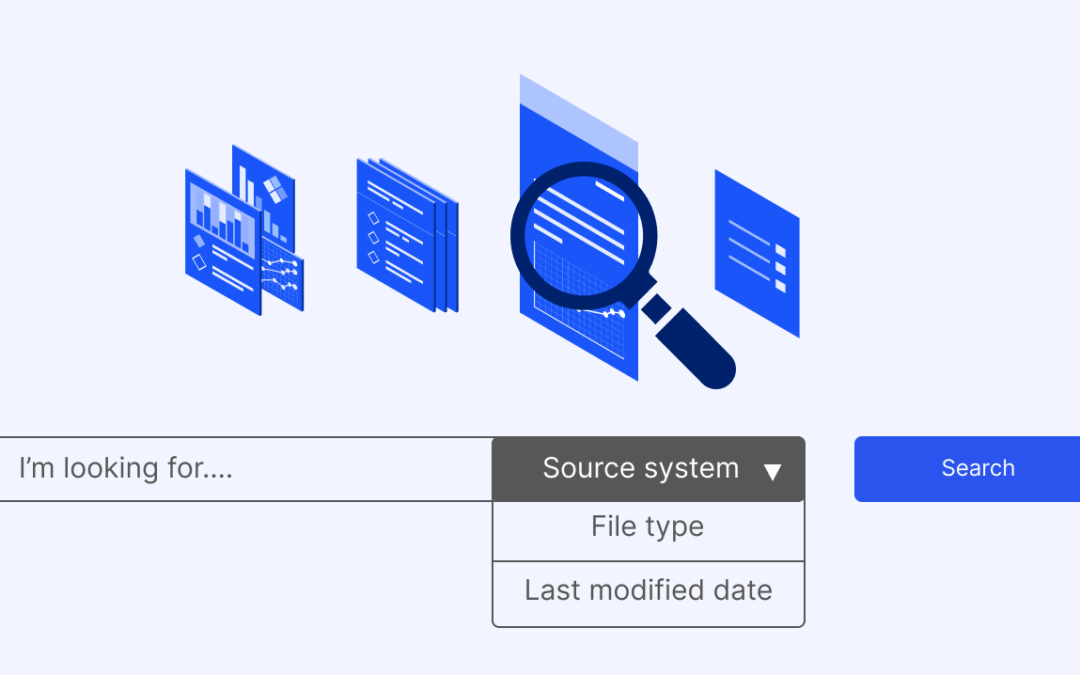
How agentic AI and intelligent ITSM are redefining IT operations management
Agentic AI marks the next major evolution in enterprise automation, moving beyond systems that merely respond to commands toward AI that can perceive, reason, act and improve autonomously.

What is an enterprise search engine? A guide to AI-powered information access
An enterprise search engine is a specialized software that enables users to securely search and retrieve information from across an organization’s internal data sources and systems.

A comprehensive guide to AgentOps: Scope, core practices, key challenges, trends, and ZBrain implementation
AgentOps (agent operations) is the emerging discipline that defines how organizations build, observe and manage the lifecycle of autonomous AI agents.
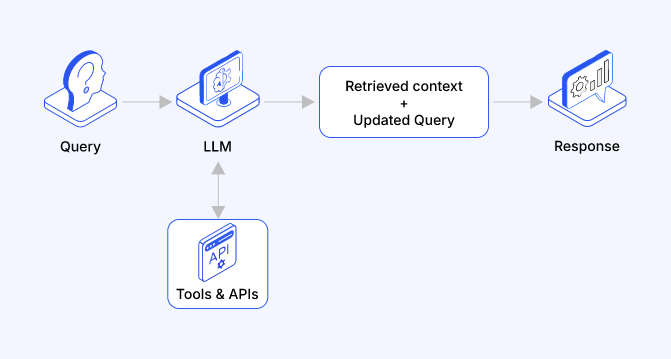
Adaptive RAG in ZBrain: Architecting intelligent, context-aware retrieval for enterprise AI
Adaptive Retrieval-Augmented Generation refers to a class of techniques and systems that dynamically decide whether or not to retrieve external information for a given query.
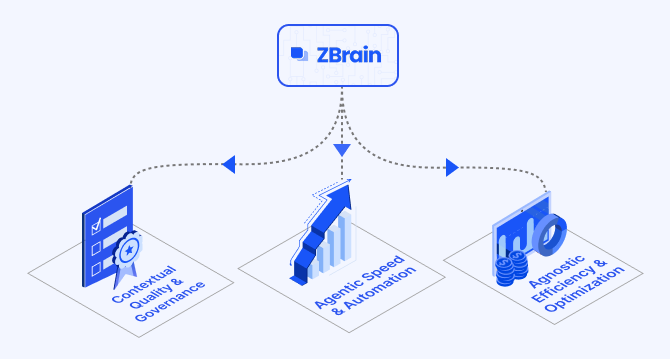
How ZBrain breaks the trade-offs in the AI iron triangle
ZBrain’s architecture directly challenges the conventional AI trade-off model—the notion that enhancing one aspect inevitably compromises another.
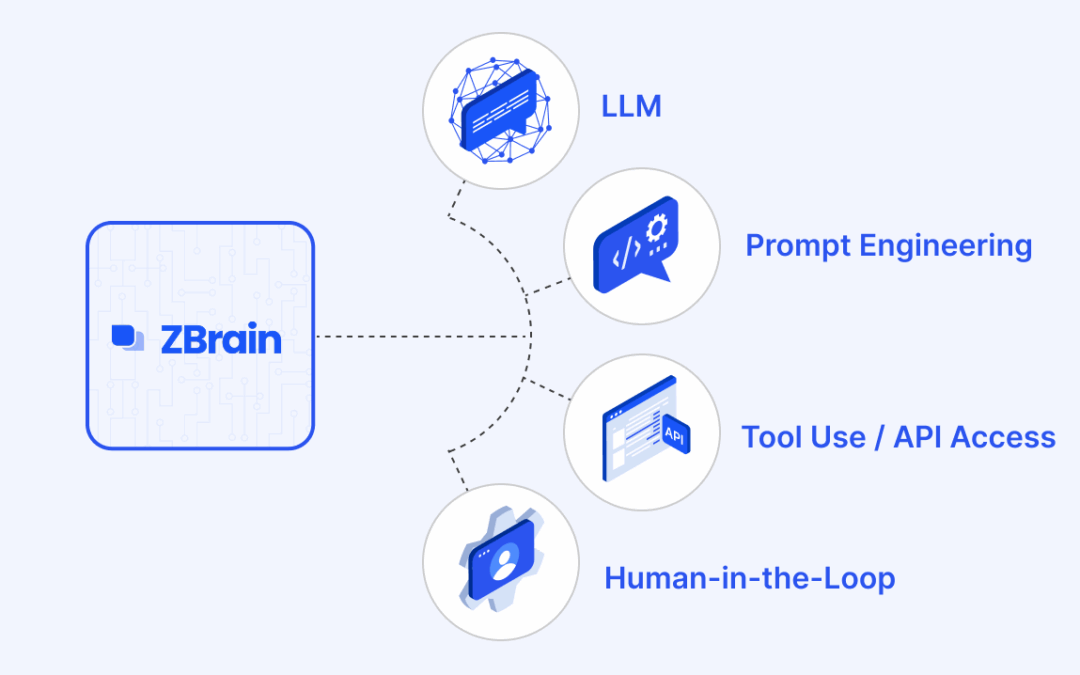
ZBrain Builder’s AI adaptive stack: Built to evolve intelligent systems with accuracy and scale
ZBrain Builder’s AI adaptive stack provides the foundation for a modular, intelligent infrastructure that empowers enterprises to evolve, integrate, and scale AI with confidence.
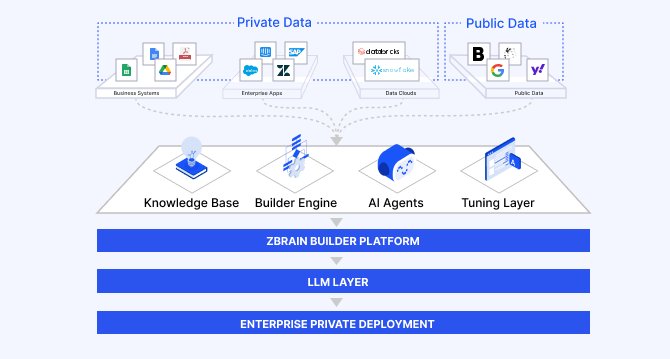
Automated AI workflows with ZBrain: Flows, LLM agents and orchestration patterns
ZBrain enables enterprises to design workflows that are intuitive for teams, efficient in execution, and adaptable to evolving business needs—transforming automation into a strategic advantage.
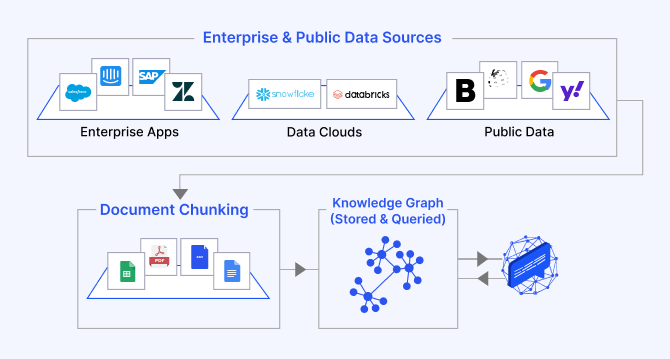
The role of knowledge graphs in building agentic AI systems: Architecture, reasoning, and ZBrain’s implementation
ZBrain Builder leverages knowledge graphs to improve contextual precision and enable reliable multi-hop reasoning in its agent responses.

ZBrain Builder: The agnostic agentic AI platform redefining enterprise AI orchestration
ZBrain Builder simplifies many aspects of AI development through its low-code interface and agnostic integration capabilities, maximizing its value depends on thoughtful planning across deployment, configuration, governance, and integration.







